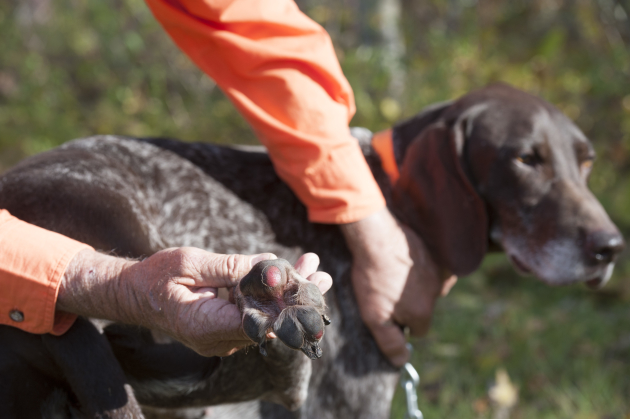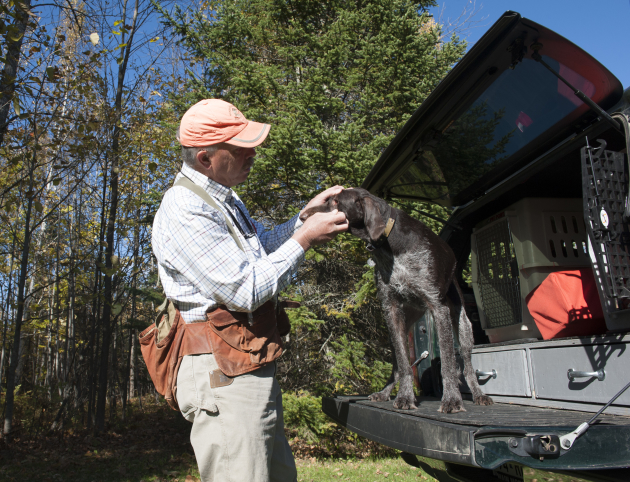Note: A guest post from our friends at Purina Pro Plan Sport.
There are hidden dangers that can happen at any time when afield. More times than not, a dog suffering an injury or mishap is worthy of being examined by a veterinarian, so it is important to know what to do should an emergency arise.
“The most common injuries in sporting dogs are traumatic or puncture wounds from running into obstacles such as trees, barbed wire, or fence posts that they didn’t see because of tall cover or some other reason,” says Joe Spoo, DVM, DACVSMR, and hunting enthusiast. “It’s crucial to research veterinarians who can treat canine athletes near your hunting destination.”
Because accidents can happen at any hour, you also should identify an emergency veterinary clinic with 24/7 access, if possible. Make contact with the clinic and jot down emergency or after-hour contact information.
“Emergency veterinary clinics often have specialists on staff who are trained to handle emergencies and critical-care cases,” explains Purina Senior Veterinary Communications Manager RuthAnn Lobos, DVM. “This is important in the initial assessment of your dog’s injury, as well as during continued care and case management.”

Photo courtesy of Purina Pro Plan
Similarly, keep a canine first-aid kit on hand while traveling. The kit should contain items such as absorbent gauze pads, elastic bandages, tape, tweezers, antiseptic, antibiotic ointment, antihistamine, saline solution, and any medications prescribed by your veterinarian. Keep the contact information for a veterinarian and emergency clinic inside the kit so everything is in one place.
Among the possible injuries and conditions that could occur are:
- Lacerations, abrasions, or bleeding from barbed wire, traps, briars, or rough cover
- Puncture wounds to the chest or abdominals
- Fractured, dislocated, or broken bones, including legs, ribs, toes, or tails
- Bites from insects or snakes
- Ingested poisons
- Damage to the eyes or nose from porcupine quills, grass awns, or cactus spines
- Low blood sugar
- Collapse from heat stroke or hypothermia
Regardless of the ailment, time is of the essence. For bites and traumatic/puncture injuries, first stabilize the dog’s wound by wrapping it with a clean towel or blanket.
“If you think your dog has a broken bone, put some ice in a plastic bag and cover it with a pillow case or towel before icing the area for ten minutes at a time,” Dr. Lobos says. “If the dog has a cut or gash, lightly clean the wound and cover it with a bandage to keep out debris and avoid infection before transporting your dog from the field.”
For other conditions, such as ingested poisons or damage to the eyes or nose, Dr. Lobos advises taking your dog to the veterinarian as soon as possible. If you suspect your dog’s blood sugar is low, which is noted by lethargy or fatigue and followed by loss of appetite, staggering gait, incoordination, and muscle twitching, give him or her sugar water or an oral concentrated solution of glucose, such as corn syrup. Seek veterinary care immediately for persisting clinical signs.
A dog with other common ailments, such as suffering from heat stroke or hypothermia, should be stabilized before being transported to the veterinarian. Heat stroke can be addressed by moving your dog to a cool place right away and applying ice packs to the head, neck, groin, and underarms. Give your dog cool, but not ice-cold, water to drink. Hypothermia can be managed by drying off your dog if he or she is wet, then wrapping the dog in a warm blanket or towel.
When taking your dog to the veterinarian or emergency veterinary clinic, be sure to keep him or her stable. The dog should be kept inside the vehicle throughout the trip.
“Although it may be tempting to comfort your dog with treats or food, it’s best to keep his or her stomach empty in the instance he or she must undergo anesthesia for the injury,” says Dr. Lobos.
It is crucial to take steps to help ensure you and your dog have a safe and enjoyable hunting experience. Be sure to research emergency veterinary clinics and pack a first-aid kit. Most importantly, know your dog well and be able to readily recognize signs of something wrong.
For more tips on keeping your gundog healthy and happy, visit proplansport.com today.

